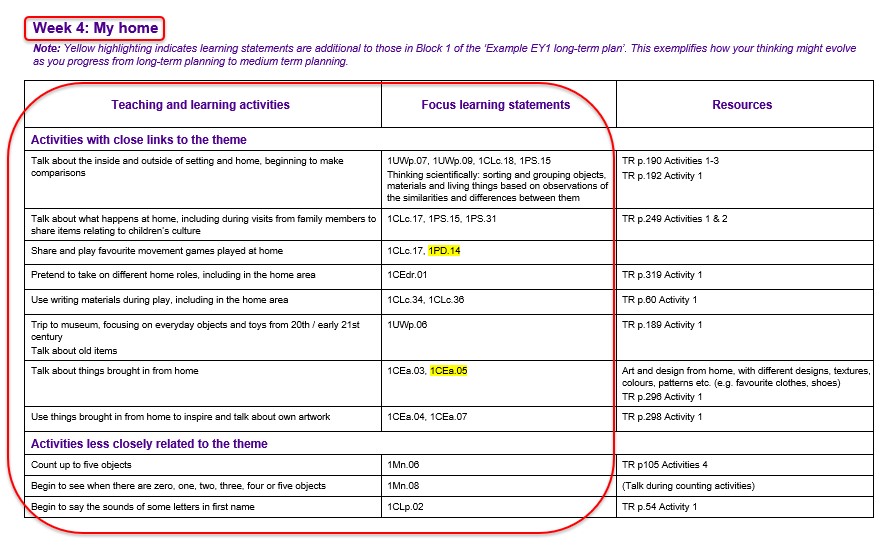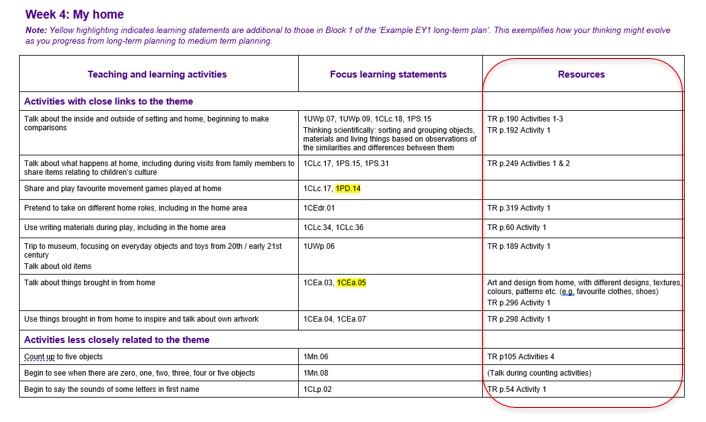Planning
Medium-term planning
Medium-term planning builds on long-term planning. It involves more detailed thinking about possible teaching and learning activities for the next whole or half term/semester.
Your medium-term planning needs to build on your children’s progress in the previous whole or half term/semester. It should be flexible so you can respond to your ongoing observations of your children’s needs and interests as the term/semester progresses.
The example medium-term plan below develops Block 1 from the ‘Example EY1 long-term plan’. It also shows one way that the Cambridge Early Years Teacher’s Book ideas might be combined with other activities to match the needs and interests of a particular group of children and ensure full development of all learning statements.
This example medium-term plan is for EY1 Block 1. It shows one possibility for how you might use the Teacher Resource together with your own activities:
Example EY1 Block 1 medium-term plan Related example EY1 long-term plan Example medium-term plan templateNotes:
- ‘Block’ in the example medium-term plan means five weeks with a focus theme.
- The level of detail in the example medium-term plan aims to demonstrate the thinking behind the planning. Your own medium-term planning might be less detailed.
The steps below will help you with your own medium-term planning for whole or half terms/semesters based on your long-term planning.
Step 1: Plan your continuous provision enhancements for the block
Begin to plan how you will adapt your usual continuous provision to help develop learning for your block. Think about:
- temporary enhancements to your existing continuous provision that will help develop children’s learning during the block
- possible guided play opportunities to develop learning towards the focus learning statements for the block
- the learning statements that the enhancements relate to.

Step 2: Plan outline activity ideas
Refine the teaching and learning opportunities from your long-term plan into activity ideas. Think about:
- how you will group your activities into weeks
- which learning statements each activity will develop or consolidate based on:
- your long-term plan
- your children’s prior experience, including your observations of their needs during the previous whole or half term/semester
- how activities with close links to the theme will develop learning statements from different curriculum areas in a balanced, holistic way
- which learning statements will be most effectively developed through activities that are less closely linked to the theme
- opportunities to develop mathematical thinking skills and scientific thinking skills (see the Curriculum for more guidance on mathematical thinking skills and scientific thinking skills).

Step 3: Note significant resources
When noting key resources for your activity ideas, include:
- activities from the Cambridge Early Years Teacher’s Book that you will use directly or adapt for your own theme
- other particularly significant resources, for example, stories or other texts.

Step 4: Refine your ideas for each week
Check that:
- there will be enough time for children to develop secure learning towards the learning statements
- there is a a balance of learning from the different curriculum areas in each week.
You can refine the order of activities within each week
during your short-term planning.
Step 5: Check progression of learning
Your thinking will evolve across the planning processes. The learning statements you decide to develop and consolidate in your medium-term planning are likely to be different from those in your long-term plan. So, you need to consider how you will continue to ensure:
- progression of learning from the previous whole or half term/semester
- learning statements are still fully covered across the year
- there is effective progression of learning across the year.